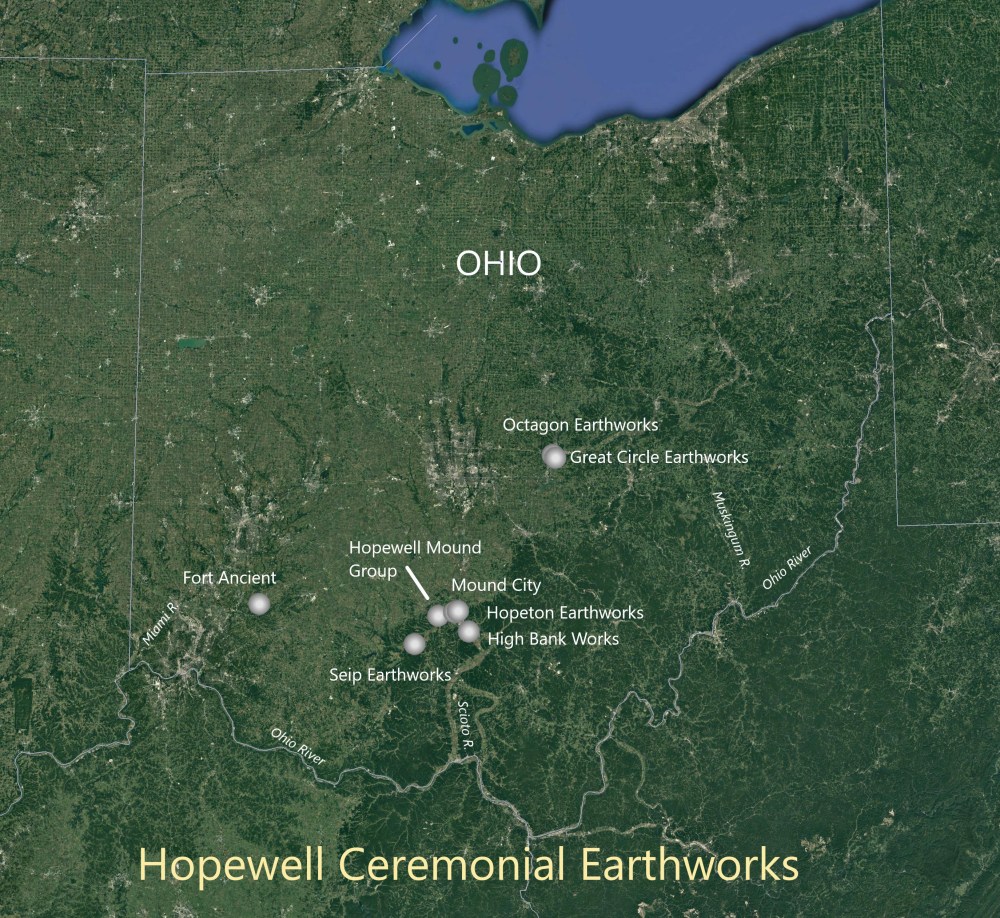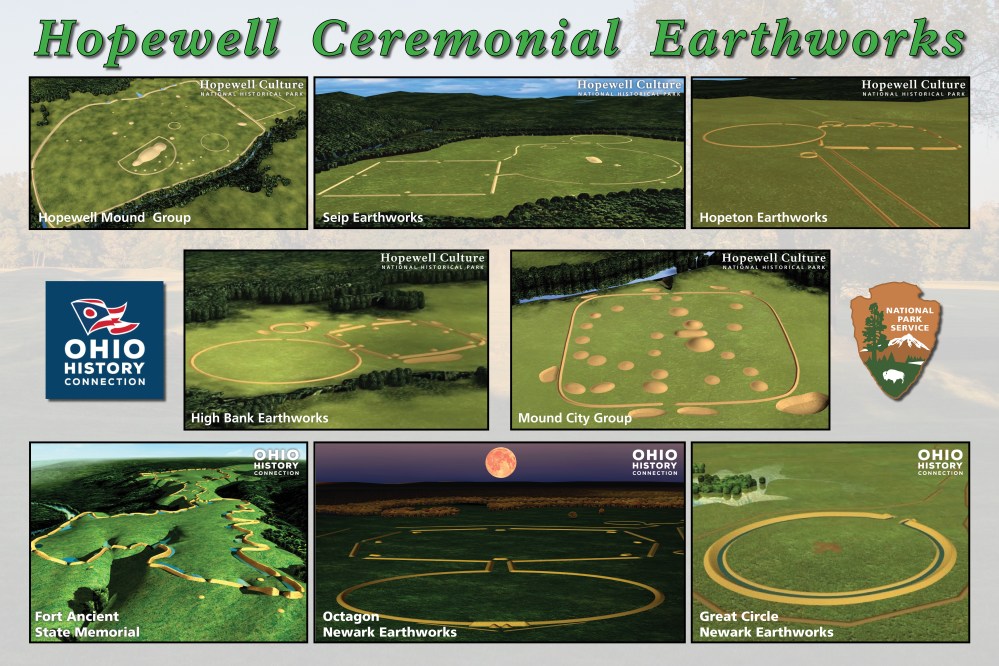Written by Andrew Sawyer, Education Outreach Specialist
Update: Hopewell Ceremonial Earthworks Added to World Heritage List
The Hopewell Ceremonial Earthworks were approved by UNESCO’s World Heritage Committee for inclusion on the World Heritage List during its meeting on September 19, 2023 in Riyadh, Saudi Arabia. UNESCO’s World Heritage Committee recognized the “outstanding universal value” and “human creative genius” in the construction and design of these sites and it is fitting that the first properties from Ohio to be added to this prestigious list were created by Indigenous People, the first people to occupy this land, between about 1,600 and 2,000 years ago. Chief Glenna Wallace of the Eastern Shawnee Tribe of Oklahoma accepted the World Heritage inscription on behalf of the delegation which included Logan York, the Tribal Historic Preservation Officer for the Miami Tribe of Oklahoma, and representatives from the Pokagon Band of Potawatomi, the Seneca Nation, the Wyandotte Nation, Ohio History Connection, the National Park Service, and the US Ambassador to Saudi Arabia who all attended the meeting.
A group of earthworks in Ohio dating to almost 2,000 years ago are in line to be considered for World Heritage status by the United Nations this summer. If listed, these earthworks would be the first sites added to the World Heritage List from Ohio, the sixth set of Native American properties, and just the 25th overall property from the United States to be added.
What is the World Heritage List?
The World Heritage List is an international inventory of cultural and natural properties selected by the United Nations Educational, Scientific and Cultural Organization (UNESCO) that exhibit “Outstanding Universal Value” to humanity. Properties are inscribed on the list to be protected for future generations to appreciate and enjoy. The World Heritage List was established with the adoption of the Convention concerning the Protection of the World Cultural and Natural Heritage by UNESCO in 1972. Since then, 194 countries have ratified the convention and, to date, over 1,100 sites in 167 countries have been added to the list including the Pyramids of Egypt, the Great Barrier Reef in Australia, the Galápagos Islands in Ecuador, the Taj Mahal in India, the Acropolis in Greece, and the Grand Canyon in the U.S.
The expected vote on these properties will be the culmination of a lengthy process that began 17 years ago. In 2006 the National Park Service (NPS) sought applications for properties that the U.S. would consider nominating to the World Heritage List. In 2008 the Ohio History Connection (OHC, then the Ohio Historical Society) and NPS submitted an application for a group of Hopewell Ceremonial Earthworks to be added to the “United States’ Tentative List.” Sites from this list are eligible to be invited to prepare a full World Heritage nomination through the U.S. National Park Service’s Office of International Affairs. The Hopewell Ceremonial Earthworks include eight (8) sites across central and southern Ohio including the Great Circle in Heath and Octagon Earthworks in Newark (both east of Columbus), the Fort Ancient Earthworks northeast of Cincinnati, and five sites that are managed by Hopewell Culture National Historical Park in and around Chillicothe: Mound City Group, Hopewell Mound Group, Seip Earthworks, Hopeton Earthworks, and High Bank Earthworks. The goal of this effort is to gain international recognition for some of the Indigenous earthworks across what is now the State of Ohio. Two other nominations from Ohio were submitted at the same time as the Hopewell Ceremonial Earthworks: Serpent Mound and a group of Dayton Aviation Sites. To date, neither of these have been officially considered for World Heritage status.

Properties that get added to the World Heritage list must demonstrate that they exhibit “Outstanding Universal Value” in at least one of ten criteria established by UNESCO. The nomination for these Hopewell sites proposes that they meet two of the criteria for cultural sites: 1- that they “represent a masterpiece of human creative genius” due to the geometric precision, scale, and complexity exhibited in the construction of the earthworks as well as the solar and lunar alignments incorporated into their construction, and; 2- because they “bear a unique or at least exceptional testimony to a cultural tradition or to a civilization which is living or which has disappeared.” The nomination was officially forwarded to the World Heritage Centre for consideration in January of 2022 with the expectation that a vote would take place in 2023. That vote and a final decision on the Hopewell Ceremonial Earthworks nomination is scheduled for later this year when the World Heritage Committee meets in Saudi Arabia from September 10-25.
World Heritage Convention guidelines encourage property managers to partner with Indigenous Peoples in the identification, nomination, management and protection of World Heritage properties. With this in mind, the World Heritage Ohio Ambassadors who prepared and submitted the nomination consulted with the National Congress of American Indians and Federally Recognized Tribes with historic ties to Ohio including the Eastern Shawnee Tribe, Miami Tribe, Ottawa Tribe, Peoria Tribe, Pokagon Band of Potawatomi, Seneca Nation, Seneca-Cayuga Tribe, Shawnee Tribe, and the Wyandotte Nation. Chief Glenna Wallace of the Eastern Shawnee Tribe was quoted in a BBC story on the earthworks: “I just want people to know about it,” said Chief Wallace, “I want people to be able to see it. I want people to be able to visit it and want people to realise that it is a cultural phenomenon. That it’s priceless.”
The Hopewell and their earthworks
The Hopewell period, as defined by archaeologists, lasted from approximately 100 BCE (2,100 years ago) to about CE 500 (1,500 years ago). Based on archaeological investigations, the Hopewell appear to have relied on a subsistence strategy that combined the hunting and gathering of wild food sources with the cultivation of domesticated crops from what is known as the Eastern Agricultural Complex (EAC). The EAC included squash, sunflowers, and plants many Americans might consider weeds today like goosefoot, maygrass, and marshelder. The sites selected for this nomination include large-scale geometric earthworks that incorporate circles, squares, octagons, and other distinctive shapes into their construction (Great Circle, Octagon Earthworks, Mound City Group, Hopewell Mound Group, Seip Earthworks, Hopeton Earthworks, and High Bank Earthworks) as well as a hilltop enclosure (Fort Ancient) with earthen walls that enclose an area following the contours of the landscape.

These sites have been interpreted by many archaeologists as pilgrimage and ceremonial destinations for communities from across most of what is now eastern North America. The repeated use of geometric shapes and a consistent unit of measurement, while often incorporating apparent astronomical alignments into their construction, are hallmarks of these monumental earthworks. Along with this, the region appears to have been at the center of a religious and interaction sphere that utilized exotic, or non-local, materials from at least as far away as the Rocky Mountains that was used to create distinctive Hopewell objects. Many of their designs and influences can be found at sites throughout the eastern half of the continent during this time period as well. All of these attributes suggest that Hopewell cultural practices were shared with a geographically dispersed, non-hierarchical, and yet socially connected, population.

The name “Hopewell” itself does not originate from Indigenous Peoples. That name comes from Mordecai Hopewell who owned a farm in Ross County, OH that included a prominent mound group. That site, and eventually the culture, were named for the landowner on whose property some of the earliest investigations into this era of earthwork construction were undertaken. Various estimates suggest that as much as 75-90% of the mounds and earthworks that once existed in what is now Ohio have been destroyed or substantially impacted by development, agriculture, looting, or other disturbances. The sites included in the World Heritage nomination exemplify the best preserved and most representative surviving examples of the enclosures built by the Hopewell culture in the central Ohio River Valley between the first and fourth centuries CE.
There are many benefits of gaining World Heritage status. One of these is the global recognition that these sites would receive bringing more exposure and attention to the Hopewell era earthworks, their Indigenous creators, their descendant communities, and the opportunities to tell their stories. Of course the State of Ohio and many local businesses also hope that this type of recognition will generate growth in heritage tourism and their local economies. Many sites that have been inscribed on the World Heritage List have experienced substantial growth in visitation as well as infrastructure investment in their neighboring communities to help handle the increased tourism.
For more on World Heritage and the Hopewell Ceremonial Earthworks see:
- BBC Travel- The US’ 2,000-year-old mystery mounds: https://www.bbc.com/travel/article/20221204-the-us-2000-year-old-mystery-mounds
- Fort Ancient Earthworks and Nature Preserve: https://www.ohiohistory.org/visit/browse-historical-sites/fort-ancient-earthworks-nature-preserve/
- Hopewell Ceremonial Earthworks Sites: http://worldheritageohio.org/hopewell-ceremonial-earthworks/
- Hopewell Culture National Historical Park, Hopewell Ceremonial Earthworks: https://www.nps.gov/hocu/learn/historyculture/hopewell-ceremonial-earthworks.htm
- Newark Earthworks: https://www.ohiohistory.org/visit/browse-historical-sites/newark-earthworks/
- Ohio History Connection Support World Heritage: https://www.ohiohistory.org/visit/special-attractions/world-heritage-site-nomination/
- UNESCO World Heritage List: https://whc.unesco.org/en/list/
- World Heritage Ohio: http://worldheritageohio.org/
Related Posts:
Updated: September 20, 2023